Queen's University of Belfast: Difference between revisions
No edit summary |
|||
| Line 116: | Line 116: | ||
Queen's provides housing for both undergraduates and postgraduates, although because of the compact size of Northern Ireland many students chose to live at home and commute to the university. In 2005/06, 36% of Queen's students lived in private accommodation within Belfast, 29% lived with parents or guardians, 20% in private accommodation outside of Belfast, and 10% lived in university maintained accommodation.<ref>{{cite web|publisher=The Planning Service|url=http://www.planningni.gov.uk/AreaPlans_Policy/Plans/BMA/HMO/Supplementary_docs/HMA.pdf|format=PDF|title=Supplementary Document 1: Housing Market Analysis, Houses in Multiple Occupation (HMOs): Subject Plan for Belfast City Council Area 2015|page=14|accessdate=26 August 2007}}</ref> | Queen's provides housing for both undergraduates and postgraduates, although because of the compact size of Northern Ireland many students chose to live at home and commute to the university. In 2005/06, 36% of Queen's students lived in private accommodation within Belfast, 29% lived with parents or guardians, 20% in private accommodation outside of Belfast, and 10% lived in university maintained accommodation.<ref>{{cite web|publisher=The Planning Service|url=http://www.planningni.gov.uk/AreaPlans_Policy/Plans/BMA/HMO/Supplementary_docs/HMA.pdf|format=PDF|title=Supplementary Document 1: Housing Market Analysis, Houses in Multiple Occupation (HMOs): Subject Plan for Belfast City Council Area 2015|page=14|accessdate=26 August 2007}}</ref> | ||
[[File: | [[File:Elms Village, Malone Road, Belfast - geograph.org.uk - 713461.jpg|right|thumb|200px|Elm's Village, student accommodation]] | ||
The university provides accommodation on a purpose-built 'student village' called Elms Village, which has its own bar and shop, located on the Malone Road, south of the main campus, as well as in a number of houses in the South Belfast area, including at College Gardens and on Mount Charles.<ref>{{cite web|url=http://www.qub.ac.uk/directorates/StudentAccommodationServices/Filetoupload,103200,en.pdf |format=PDF |title=Where to stay at Queen's |publisher=Queen's Accommodation and Hospitality |accessdate=3 September 2008 |deadurl=yes |archiveurl=https://web.archive.org/web/20080911061151/http://www.qub.ac.uk/directorates/StudentAccommodationServices/Filetoupload,103200,en.pdf |archivedate=11 September 2008 }}</ref> | The university provides accommodation on a purpose-built 'student village' called Elms Village, which has its own bar and shop, located on the Malone Road, south of the main campus, as well as in a number of houses in the South Belfast area, including at College Gardens and on Mount Charles.<ref>{{cite web|url=http://www.qub.ac.uk/directorates/StudentAccommodationServices/Filetoupload,103200,en.pdf |format=PDF |title=Where to stay at Queen's |publisher=Queen's Accommodation and Hospitality |accessdate=3 September 2008 |deadurl=yes |archiveurl=https://web.archive.org/web/20080911061151/http://www.qub.ac.uk/directorates/StudentAccommodationServices/Filetoupload,103200,en.pdf |archivedate=11 September 2008 }}</ref> | ||
Revision as of 19:42, 1 October 2017
| The Queen's University of Belfast | |
|
Pro tanto quid retribuamus | |
|---|---|
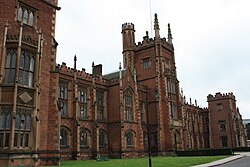
| |
 | |
| Founded: | 1810 |
| Chancellor: | Thomas Moran |
| Type: | Urban |
| Endowment: | £56.6m (31 July 2016) |
| Location | |
| Grid reference: | J33567260 |
| Location: | 54°35’3"N, 5°56’5"W |
The Queen's University of Belfast, which is more usually known as 'Queen's University Belfast' or just 'Queen's', is a public research university in Belfast. The university was chartered in 1845, and opened in 1849 as "Queen's College, Belfast", but has roots going back to 1810 and the Royal Belfast Academical Institution.[1]
The university forms the focal point of the Queen's Quarter area of the city, one of Belfast's four cultural districts. It offers academic degrees at various levels and across a broad subject range, with over 300 degree programmes available.
Queen's is a member of the Russell Group of leading research intensive universities, the Association of Commonwealth Universities, the European University Association, Universities Ireland and Universities UK. The university is associated with two Nobel laureates and one Turing Award laureate.
History
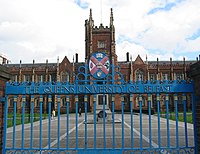
Queen's University Belfast has its roots in the Belfast Academical Institution, which was founded in 1810, one of the United Kingdom's 10 oldest universities, and remains as the Royal Belfast Academical Institution.[1] The present university was first chartered as "Queen's College, Belfast" in 1845, when it was associated with the simultaneously founded Queen's College, Cork, and Queen's College, Galway, as part of the Queen's University of Ireland – founded to encourage higher education for Presbyterians and Roman Catholics, as a counterpart to Trinity College, Dublin, then an Anglican institution.[1] Queen's College, Belfast, opened in 1849.[1] Its main building, the Lanyon Building, was designed by the architect Sir Charles Lanyon.
At its opening, the university had 23 professors and 343 students. Some early students at Queen's University Belfast took University of London examinations.
The Irish Universities Act, 1908 dissolved the Royal University of Ireland, which had replaced the Queen's University of Ireland in 1879, and created two separate universities: the current National University of Ireland and Queen's University of Belfast.[1]
Parliamentary representation
The university was one of only eight United Kingdom universities to hold a parliamentary seat in the House of Commons at Westminster until such representation was abolished in 1950. The university was also represented in the Parliament of Northern Ireland from 1920 to 1968; its graduates elected four seats.
Modern day
On 20 June 2006, the university announced a £259 million investment programme focusing on facilities, recruitment and research.[2] One of the outcomes of this investment has been a new university library; the McClay library was designed by Boston-based architects Sheply, Bulfinch, Richardson & Abbott, working in association with Belfast architects, Robinson Patterson Partnership, and opened in July 2009. The building has been named in honour of Sir Allen McClay, a major benefactor of Queen's University and of the Library.[3]
In June 2010, the university announced the launch of a £7.5m Ansin international research hub with Seagate Technologies.[4]
The only Juris Doctor degree currently awarded by a UK university is at Queens University Belfast, perhaps in part due to Northern Ireland's specific set of laws.[5][6]
Queen's is one of the largest employers in Northern Ireland, with a total workforce of 3,903, of whom 2,414 were members of academic, academic-related and research staff and 1,489 were administrative employees.[7]
Campus
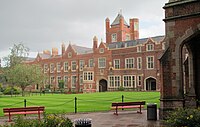

In addition to the main campus not far from the centre of Belfast, the university has two associated university colleges, St Mary's and Stranmillis, both also located in Belfast. Although offering a range of degree courses, these colleges primarily provide training for those wishing to enter the teaching profession. The university has formal agreements with other colleges in Northern Ireland and operates several outreach schemes to rural areas.
While the university refers to its main site as a campus,[8] the university's buildings are in fact spread over a number of public streets in South Belfast, centring on University Road, University Square and Stranmillis Road, with other departments located further afield.
Organisation
Faculties and schools
Academics at Queen's are organised into fifteen schools across three faculties. The three faculties are the Faculty of Arts, Humanities & Social Sciences, the Faculty of Engineering & Physical Sciences and the Faculty of Medicine, Health & Life Sciences. Each of the 20 schools operates as a primary management unit of the university and the schools are the focus for education and research for their respective subject areas.
- School of Biological Sciences
- School of Chemistry and Chemical Engineering
- School of Electronics, Electrical Engineering and Computer Science
- School of Arts, English and Languages
- School of History, Anthropology, Philosophy and Politics
- School of Law
- Queen’s Management School
- School of Mathematics and Physics
- School of Mechanical and Aerospace Engineering
- School of Medicine, Dentistry and Biomedical Sciences
- School of Nursing and Midwifery
- School of Pharmacy
- School of Natural and Built Environment
- School of Psychology
- School of Social Sciences, Education and Social Work
Other Academic Provision
- Gibson Institute - The Institute is involved in education and research in the areas of sustainability, rural development, environmental management, food marketing, renewable energy, nutrition, physical activity and public health
- Institute for Collaborative Research in the Humanities - The Institute, established in 2012, provides strategic leadership at Queen’s to support and enhance world class interdisciplinary research in the Humanities at all levels. On Feb 18th 2016 BBC Northern Ireland reported that this Institute was to be closed.[9]
- Institute for Global Food Security - The Institute houses a suite of state-of-the-art laboratories, conducting cutting edge research into various topics ranging from soil & plant health through to food security.
- Institute for the Study of Conflict Transformation and Social Justice - The purpose of the Institute is to facilitate sustained interdisciplinary collaboration in research and teaching and to provide strategic focus to support world class research in this field.
- Institute of Cognition and Culture - Founded in 2004, this is one of the world’s first centres for research in the cognitive science of culture. It has brought together a range of cutting-edge cognitive scientists via a series of visiting fellowships.
- Institute of Electronics, Communications and Information Technology (ECIT) - established in 2003 to commercialise world-class research and expertise in a variety of enabling digital communications technologies at the School of Electronics, Electrical Engineering and Computer Science at Queen’s University Belfast.
- Institute of Irish Studies - The Institute of Irish Studies celebrated its 50th birthday in March 2015. It was the first of its kind to be established in the world and is one of the leading centres for research-led teaching in Irish Studies and is an internationally renowned centre of interdisciplinary Irish scholarship.
- Institute of Professional Legal Studies - The Institute of Professional Legal Studies was established in 1977 at Queen's University Belfast. It provides an internationally recognised and unique one-year postgraduate course for trainee barristers and trainee solicitors who study together.
- Institute of Spatial and Environmental Planning (ISEP) - The Institute of Spatial and Environmental Planning (ISEP) has a very wide range of research projects built on strong international, interdisciplinary and theoretical references.
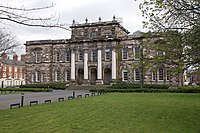
- Institute of Theology - Consists of several colleges with a Christian emphasis, including St Mary's (Roman Catholic), Union Theological College (Presbyterian), Belfast Bible College (non-denominational), as well as Baptist and Methodist colleges in Belfast. In all five colleges teach any programmes with a theological emphasis on behalf of the university; the university may confer theology degrees but cannot teach the subject itself.
- William J Clinton Leadership Institute - The William J Clinton Leadership Institute at Riddel Hall brings world class facilities, leading academics and industry experts together to deliver a high end portfolio of executive education and leadership programmes.
Academic profile
Queen's University Belfast was admitted to the Russell Group of UK research-intensive universities in November 2006.[10][11] Queen’s University was placed joint 8th in the UK for research intensity following the Research Excellence Framework 2014 (REF). The UK-wide research assessment of higher education institutions placed Queen’s in the top 20 for research quality and impact. It also confirmed that over 75% of the institutions research is world-class or internationally leading with over 95% of Queen’s academic staff returned for assessment, the University has 14 subject areas ranked within the UK’s top 20 with six of these in the top 10, and two in the top five.[12]
The Times Higher Education rankings 2015/16 placed Queen’s 200th in world and in 2014 reported it in the top 25 most international universities.[13] In the 2016 QS World University Rankings Queen's was ranked 182nd.
The university has also been awarded by the Queen's Anniversary Prize for Further and Higher Education on several occasions, including for their work in comprehensive cancer services improving survival rates for patients in Northern Ireland. In 2015, Queen's was awarded for its work in the field of engineering and technology[14]
Student life
Students' Union
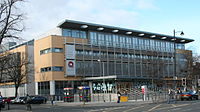
The Students' Union at Queen's (QUBSU) is located opposite the Lanyon Building on University Road, and is provided for under the University's Statutes. All students at the University are automatic members of the Union, making it one of the largest Unions on a single campus in the British Isles. It is administered by the Students' Representative Council (SRC) (elected every October, on a Faculty basis) and an Executive (elected in March), who manage the operations of the Union in conjunction with several full-time staff.
A range of services are provided by the Students' Union following its reopening in March 2007 after a £9 million redevelopment, including an Advice Centre with full-time staff to help with issues such as money problems, accommodation and welfare. Commercial services are also provided for by the Union and include a shop, canteen and coffee franchise. There are also four bars within the building, the biggest of which, the Mandela Hall, hosts numerous concerts each year as well as the majority the Students' Union's club nights.
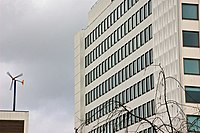
Clubs and societies
More than fifty sporting clubs and over 100 non-sporting societies are recognised by the Student's Union Council and therefore eligible to apply for an annual grant from the University.[15] The oldest society in Queen's University is the Literary and Scientific Society which focuses on debating political, cultural and social issues within Northern Ireland. Established in 1850 by Edwin Lawrence Godkin, the society has been very successful and produced some of the finest orators in Ulster. The Dragonslayers Gaming Society hosts one of Ireland's largest games conventions, Q-Con, in June of each year, and cultural groups such as An Cumann Gaelach and the Ulster-Scots Society are also present.
The Queen's University Mountaineering Club is notable for producing three Everest summiteers including Ireland's first, Dawson Stelfox.[16] Roger McMorrow and Nigel Hart also summited in May 2007, and were subsequently jointly announced Queen's University Graduates of the year for 2006/07[17] for their role in rescuing a young Nepalese climber left for dead near the summit.[18]
QUB is one of only 20 Universities in the United Kingdom to have an AIESEC Local Chapter, developing leadership, business and soft skills in highly motivated students, as well as providing international opportunities through their work abroad program.
Housing
Queen's provides housing for both undergraduates and postgraduates, although because of the compact size of Northern Ireland many students chose to live at home and commute to the university. In 2005/06, 36% of Queen's students lived in private accommodation within Belfast, 29% lived with parents or guardians, 20% in private accommodation outside of Belfast, and 10% lived in university maintained accommodation.[19]
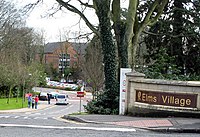
The university provides accommodation on a purpose-built 'student village' called Elms Village, which has its own bar and shop, located on the Malone Road, south of the main campus, as well as in a number of houses in the South Belfast area, including at College Gardens and on Mount Charles.[20]
Sport
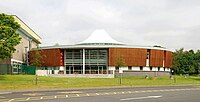
Queen's Physical Education Centre (abbreviated to and known widely as the PEC) recently went through an extension program was awarded 'Best Building 2007' by the Royal Institute of Chartered Surveyors (RICS) Northern Ireland.[21] It is one of the largest sports centres in the British Isles. This building houses many squash courts, several climbing walls and is home to QUB's senior men's and women's basketball teams.
The University Playing Fields, also known as Malone Playing Fields, is located just over two miles from the main campus, comprising 17 pitches for rugby, association football, Gaelic football, hockey, hurling, camogie and cricket. In addition, there are three netball courts, nine tennis courts and an athletics arena where the Mary Peters Track is situated. The area and its surrounding forest of Barnetts Demesne are mapped for orienteering.
Queen's Gaelic football team have won several Sigerson Cups. The university's association football team, Queen's University Belfast A.F.C., play in the Irish Second Division. Queen's snooker team have won the British intervarsity title on a record nine occasions and are the current champions.[22]
Queen's University Belfast Boat Club is one of the most successful clubs in the University. The QUB boathouse, home of Queen's University Belfast Boat Club (QUBBC) and Queen's University of Belfast Ladies Boat Club (QUBLBC), is located on the River Lagan near Stranmillis.
Outside links
- Queen's University Belfast
- Queen's University Belfast Students' Union
- Queen's University Belfast Research Portal
References
- ↑ 1.0 1.1 1.2 1.3 1.4 "History of Queen's". Queen's University Belfast. http://www.qub.ac.uk/home/TheUniversity/AboutQueens/HistoryofQueens/. Retrieved 1 March 2008.
- ↑ "Queen's invests £259 million in 'world-class future'". Queen's University Belfast. 20 June 2006. http://www.qub.ac.uk/home/TheUniversity/GeneralServices/News/ArchivesPressReleases-CampusNews/2006PressReleases/06-2006PressReleases/#d.en.31450. Retrieved 16 September 2006.
- ↑ "New library update – 27 July 2009". Library News (Queen's University Belfast). 27 July 2009. http://blogs.qub.ac.uk/library/2009/07/30/new-library-update-%e2%80%93-27-july-2009/. Retrieved 10 August 2009.
- ↑ Queen's opens £7.5m Ansin tech centre - 'Insideireland.ie', 8 June 2010
- ↑ "Programme Specification (2015-16)". Queens University Belfast. https://www.qub.ac.uk/directorates/media/Media,531912,en.pdf. Retrieved 16 September 2016.
- ↑ "Study regulations for research degree programmes". Queens University Belfast. http://www.qub.ac.uk/directorates/AcademicStudentAffairs/AcademicAffairs/GeneralRegulations/StudyRegulations/StudyRegulationsforResearchDegreeProgrammes/. Retrieved 16 September 2016.
- ↑ Vice-Chancellor's Report 2009 – 2010: Queen's University Belfast
- ↑ See http://www.qub.ac.uk/home/TheUniversity/Location/Maps/MainCampus/, for example.
- ↑ "Queen's University to close department that organised Charlie Hebdo event". http://www.bbc.co.uk/news/uk-northern-ireland-35599860.
- ↑ "The Russell Group appoints first Director General and expands membership to 20 top research universities". Russell Group. November 2006. Archived from the original on 11 March 2008. https://web.archive.org/web/20080311100222/http://www.russellgroup.ac.uk/news/2006/appointment-first-director-general-and-expands-membership-to-20-top-research-universities.html. Retrieved 1 March 2008.
- ↑ "Queen's to join UK 'ivy league'". BBC News. 7 November 2006. http://news.bbc.co.uk/1/hi/northern_ireland/6123044.stm. Retrieved 1 March 2008.
- ↑ Research excellence work 2014, 18 December 2014
- ↑ "The 25 most international universities in the world". Times Higher Education. http://www.timeshighereducation.co.uk/news/the-25-most-international-universities-in-the-world/4/2010783.article. Retrieved 24 January 2014.
- ↑ "Previous Prize-winners". http://www.royalanniversarytrust.org.uk/the-prizes/previous-prize-winners?archive%5Bkeywords%5D=The+Queen%2527s+University+of+Belfast&x=0&y=0&archive%5Byears%5D=&archive%5Bcountries%5D=&archive%5Binstitutions_type%5D=&archive%5Bsubjectarea%5D=&sort%5Binst_name%5D=asc. Retrieved 2016-01-05.
- ↑ Clubs and Societies, Queen's University website. Retrieved 15 July 2007.
- ↑ "Mr Dawson Stelfox". Open University. http://www.open.ac.uk/graduation2006/pop63047.shtml. Retrieved 15 June 2008.
- ↑ "Past Graduate & Student of the Year winners". Queen's University Belfast. https://daro.qub.ac.uk/pastwinners. Retrieved 15 June 2008.
- ↑ "BBC: NI doctors in Everest rescue drama". BBC News. 29 May 2007. http://news.bbc.co.uk/2/hi/uk_news/northern_ireland/6700603.stm. Retrieved 15 June 2008.
- ↑ "Supplementary Document 1: Housing Market Analysis, Houses in Multiple Occupation (HMOs): Subject Plan for Belfast City Council Area 2015" (PDF). The Planning Service. p. 14. http://www.planningni.gov.uk/AreaPlans_Policy/Plans/BMA/HMO/Supplementary_docs/HMA.pdf. Retrieved 26 August 2007.
- ↑ "Where to stay at Queen's" (PDF). Queen's Accommodation and Hospitality. Archived from the original on 11 September 2008. https://web.archive.org/web/20080911061151/http://www.qub.ac.uk/directorates/StudentAccommodationServices/Filetoupload,103200,en.pdf. Retrieved 3 September 2008.
- ↑ "Queen's Physical Education Centre scoops top building award". Queen's Sport. 8 June 2007. Archived from the original on 3 September 2007. https://web.archive.org/web/20070903082444/http://www.qub.ac.uk/sport/Aboutus/NewsandEvents/08-06-2007PECScoopsTopBuildingAward/. Retrieved 27 December 2007.
- ↑ Results History; British Universities & Colleges Sport – Snooker – Championships; retrieved August 2010